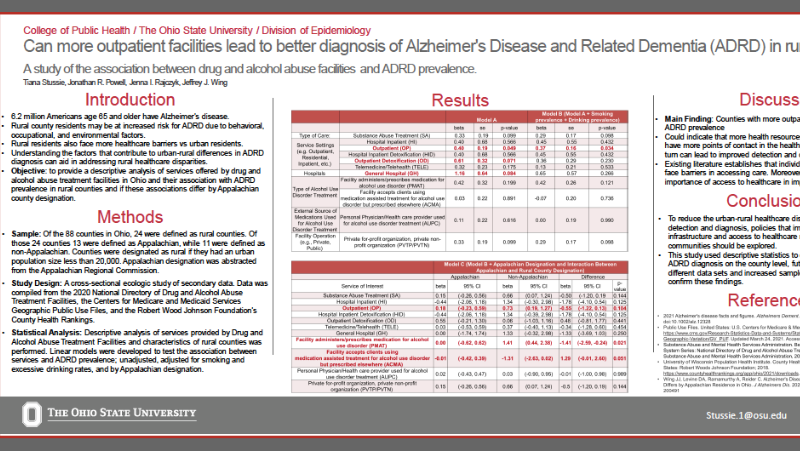
Leading through advocacy, education, and relationships
Can more outpatient facilities lead to better diagnosis of Alzheimer's Disease and Related Dementia (ADRD) in rural Ohio? A study of the association between drug and alcohol abuse facilities and ADRD prevalence.
Category: 2021
Author: Tiana Stussie
Institution Affiliation: The Ohio State University
The prevalence of Alzheimer’s disease will more than double by 2050. Rural county residents may be at increased risk for Alzheimer’s disease or related dementia (ADRD) due to behavioral, occupational, and environmental factors; however, rural residents also face more healthcare barriers compared to urban county residents. Our aim was to provide a descriptive analysis of services offered by drug and alcohol abuse treatment facilities in Ohio and their association with ADRD prevalence in rural counties. Further, we analyzed whether these associations differ by Appalachian-county designation. Using a cross-sectional ecologic design, we summarized data for the 24 rural counties in Ohio. We abstracted data on the number of drug and alcohol abuse treatment facilities from the 2020 National Directory of Drug and Alcohol Abuse Treatment Facilities. Centers for Medicare and Medicaid Public Use Files were used to estimate county-level ADRD prevalence in 2018. Data from the Robert Wood Johnson Foundation’s County Health Rankings was used for the county-level prevalence of adult smoking and excessive drinking in 2018. Descriptive analysis of services provided by Drug and Alcohol Abuse Treatment Facilities and characteristics of rural counties was performed. Linear models were developed to test the association between services and ADRD prevalence; unadjusted, adjusted for smoking and excessive drinking rates, and by Appalachian designation. We observed that within rural counties in Ohio, for each additional outpatient facility, the county-level prevalence of ADRD was 0.40% higher (p=0.049) and 0.37% higher (p=0.034) after adjustment for county-level smoking and excessive drinking prevalence. This association was largely driven by rural non-Appalachian counties. Counties with more outpatient facilities had a higher ADRD prevalence. This could indicate that more health resources allow for individuals to have more points of contact in the healthcare system, which in turn can lead to improved detection and diagnosis of ADRD.
Watch Video
 Phone: 567-712-0697
Phone: 567-712-0697
